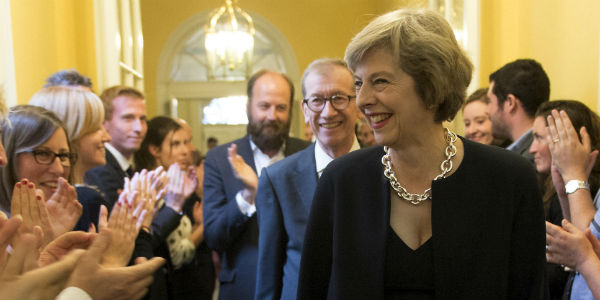How groupthink in Theresa May’s No 10 led to another round of political chaos
The UK’s political turmoil continues with a disastrous Conservative election campaign. But what led to the multiple miscalculations involved? Patrick Dunleavy argues that it forms part of a wider pattern of mis-governing from the centre of Whitehall – and it has characterised Theresa May’s leadership style from the outset.

Closed circle: Theresa May enters No 10 in 2016 with her husband Philip and one of her key advisers, Nick Timothy, behind her. Photo: Number 10 via a CC-BY-NC-ND 2.0 licence
All British Prime Ministers end their careers in failure. Either they are rejected by the electorate at the end of their term of office. Or they become overwhelmed by convictions of their own rightness and superiority, eventually triggering the covert succession battles that plagued (and eventually did for) Blair and Thatcher. It takes a special kind of PM to combine both these features, and then trigger his or her own demise far earlier than they needed to do.
Ted Heath did it in February 1974, demanding that the electorate answer ‘Who governs the country, me or the miners’ union?’ To which the electorate soon replied, ‘Well, not you’. The message most politicians absorbed from this was that voters don’t like unnecessary or repeat elections. Harold Wilson re-discovered that lesson, dissolving Parliament in October 1974 in expectation of a workable Commons majority, only to fail to get it. The shadow of 1974 more recently hovered over Gordon Brown when he decided not to call an early general election during his short-lived ‘honeymoon period’ in summer and autumn 2007.
Against this well-known background, we need to dig deep if we are to explain May’s decision to trigger an early general election out of the blue. We cannot just lament with Schiller, that ‘Against stupidity, the gods themselves contend in vain’. And it is too simple to join historian Barbara Tuchman in attributing political fiascos to ‘wooden headedness’, a stubborn persisting with courses of action whose risks are well-known.
The theory of ‘groupthink’ adds a useful extra insight here. First formulated by the psychologist Irving Janis, it specifically applies to tightly knit executive teams composed of a dominating leader and ultra-loyal assistants with a drive to maximise in-group solidarity. Suppose that in a first stage the team accomplished something extremely difficult, as May did in scheming her way to bid for the Conservative leadership. Especially important here was the intra-party arm-twisting of all the other candidates after the Brexit vote, so that she could ascend by coronation instead of having to fight an internal party election.
Janis argued that succeeding in this first stage struggle, against the odds, and with a centralising and controlling leader, then induces in the leadership team a distorted view of their own insights and capabilities. Buoyed up by high morale, contemptuous of ‘outsiders’, and completely discounting any critical feedback received, the leadership team then goes on to make genuinely monumental second stage mistakes – as Blair did in committing to the Iraq war, and later sending troops to Afghanistan; or as Cameron did in his 2013 commitment to hold a Brexit referendum, and then his mismanagement of the doomy Remain campaign in 2016.
Theresa May’s election campaign stressed the mantra of ‘strong and stable’ leadership. But the theme fell to pieces when the Tory manifesto floated three obviously un-implementable pledges (the dementia tax, ending triple-lock protections for pensions, and cutting winter fuel subsidies). Its largely un-costed pages were also packed with a series of vengeful measures against political opponents on classic ‘nasty party’ lines – such as scrapping the electoral systems which have done so much to make elected mayors successful in London and wider England. The manifesto was written by a small group of May advisors from her days at the Home Office, and a loyalist junior minister. And throughout the campaign, Downing Street sources repeatedly leaked or prompted stories of how Phillip Hammond (the Chancellor), Boris Johnson (the Foreign Secretary), and David Davies (in charge of exiting the EU) were to be variously fired or re-shuffled after the expected forthcoming landslide victory, despite their having had less than a year in office. May’s intention to gather all the reins of power into her own hands was crystal clear to insiders.
Behind the scenes though, the determination to super-centralise control in Downing Street had already brought chaos to Whitehall, both amongst ministers and top officials. On her first weekend in office, May created a Cabinet in which 21 of the 24 members were new to the role they were playing, leaving only a few isolates like Jeremy Hunt in the same department that they had run under David Cameron. And instead of creating a beefed-up unit in the ‘non-baronial’ Cabinet Office to co-ordinate Brexit negotiations, May abandoned Cameron’s policy of not reorganising Whitehall departments.
For wholly short-term political reasons she created two brand new ministries – one for Exiting the EU (DExEU), and the other for International Trade. Both are foreseeably doomed to disappear again in quick time, DExEU in summer 2019 when the Article 50 period comes to a terminus, and DIT in maybe one further year when the UK’s international trade continues stubbornly on its long-established, disappointing trend. The end result of all this shaking up the personnel? May got the political balance she needed to convert to a ‘hard Brexit’ strategy of leaving the EU fast and curbing immigration, so as to attract UKIP voters back to the Tory ranks. But meanwhile almost all ministers spent a year learning their new roles, organising reviews of policy, and getting almost nothing done.
The May team’s interfering did not stop at ministers though. In a little recognised but very consequential move for how Whitehall operates, a veritable putsch was organised to get rid of all the senior officials that May disliked (essentially anyone ‘speaking truth to power’). Instead, one by one, May’s team bullied the Cabinet Secretary, Jeremy Heywood, into replacing five out of 18 Permanent Secretaries across Whitehall, plus the vitally important head of the UK’s COREPER delegation in Brussels, so as to bring in officials more compliant to Downing Street’s complete hegemony. A further 8 Perm Secs were already new to their roles, not having held posts at the 2015 general election.
Talk to senior Whitehall officials and they are bemused at the violation of past norms of behaviour that has already gone on under Conservative majority rule. ‘It’s very difficult for Jeremy’, they murmur, in attempting to excuse his quiescence in the face of this naked politicisation. But the end result has been that two thirds of the Cabinet of ministers struggling with their new roles are also being advised by new-to-the-job Permanent Secretaries. And the senior civil service’s ability to offer frank advice has been cowed by the PM’s detailed insistence on everything going her way.
The general election outcome now adds a further layer of chaos to the underlying incoherence that is pulling the Tory party apart. As soon as she gained power, May adopted a ‘BlueKip’ strategy to progressively toughen up the UK’s Brexit negotiating position, designed solely so that the Conservatives could attract back and re-assimilate UKIP’s supporters at the secretly planned ‘quick’ general election, thereby killing off the threat of an ‘enemy on the right’ that had hamstrung David Cameron.
Policy-making was ruthlessly one-party, with no effort at bi-partisanship and no effort at all to build a ‘national consensus’ Brexit position. Everything had to be simple and vague (‘Brexit means Brexit’) and talk tough (‘no deal is better than a bad deal’) so as to function in the febrile atmosphere of the planned ‘coup’ election that would deliver secure Tory hegemony to 2022. Concessions would be made to EU priorities, but only once the election was safely cleared away. In the meantime a chorus of closely reasoned counter-arguments from many quarters were simply discounted, because the May team knew best.
The UK’s government for the foreseeable future still lies in Tory hands. Thanks to the Fixed Term Parliament Act, which she bypassed with Labour help to call the 2017 general election, the incumbent Tories are theoretically able to face down any demands for new elections until May 2022. (This is an ironic last legacy for Nick Clegg’s disastrous time in charge of constitutional affairs.) In theory all the Conservatives need do is to survive on confidence motions, which could be feasible for a while, with Democratic Unionist Party support.
Yet May’s own political future is fatally tarnished already. Her Downing Street team have gratuitously blown a workable, small majority, and (mislead by groupthink and vaunting ambition) made easily avoidable mistakes. Whatever they say in public, the rest of the Cabinet and all her MPs will be looking to her potential successors from now on, and not to May herself. Within a year to eighteen months, or two years, the likelihood is that the premier will find that her position within the Conservative party is untenable, and leave the scene of her own volition. Between now and then lies only the thankless task of reappraising the doomed ‘hard Brexit’ strategy, while trying to avoid a slide into minority government paralysis – or the triggering of yet another unwanted election.
This post represents the views of the author and not those of Democratic Audit. It first appeared at LSE British Politics and Policy.
 Patrick Dunleavy is Co-Director of Democratic Audit, Chair of the LSE Public Policy Group, and a Professor of Political Science at the LSE. His latest (co-authored) books are The Impact of the Social Sciences (Sage, 2014 – free materials here) and Growing the Productivity of Government Services (Elgar, 2013).
Patrick Dunleavy is Co-Director of Democratic Audit, Chair of the LSE Public Policy Group, and a Professor of Political Science at the LSE. His latest (co-authored) books are The Impact of the Social Sciences (Sage, 2014 – free materials here) and Growing the Productivity of Government Services (Elgar, 2013).





 Democratic Audit's core funding is provided by the Joseph Rowntree Charitable Trust. Additional funding is provided by the London School of Economics.
Democratic Audit's core funding is provided by the Joseph Rowntree Charitable Trust. Additional funding is provided by the London School of Economics.